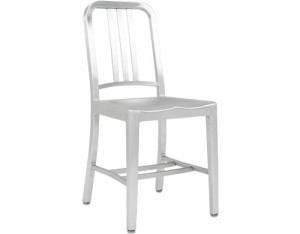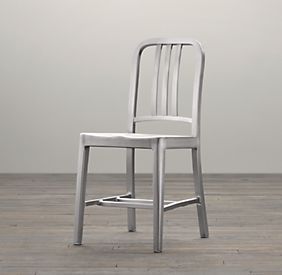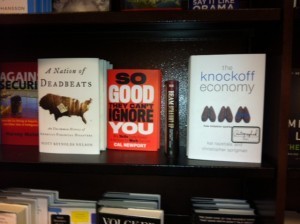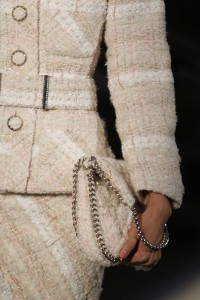Christopher Sprigman's Blog, page 9
October 2, 2012
Can Emeco prevent Restoration Hardware from knocking off the “Navy Chair”?
 The Emeco 1006 chair, also called the “Navy Chair”, is an aluminum chair produced by the Electric Machine and Equipment Company (Emeco) in Hanover, Pennsylvania. The chair, pictured at left, was commissioned in the 1940s by the United States Navy in World War II for use on warships: the contract specified that it had to be able to withstand torpedo blasts to the side of a destroyer.
The Emeco 1006 chair, also called the “Navy Chair”, is an aluminum chair produced by the Electric Machine and Equipment Company (Emeco) in Hanover, Pennsylvania. The chair, pictured at left, was commissioned in the 1940s by the United States Navy in World War II for use on warships: the contract specified that it had to be able to withstand torpedo blasts to the side of a destroyer.
After the war, Emeco began selling its Navy Chair to the public. The chair never sold particularly well, but over the years Emeco’s chair carved out a small niche as a piece of high-end (that is, expensive) design of the sort you’ll see featured in Dwell magazine.
 Until Restoration Hardware got into the act. Recently the big furniture retailer began selling a Navy look-alike chair (pictured at left), which it (now) refers to as the “standard aluminum side chair”. (It previously referred to it as the “Naval Chair”). The Emeco original is $455.00. The Restoration knockoff is $129. At that price — and given Restoration Hardware’s ubiquity and marketing muscle — the Navy Chair is poised to go mainstream.
Until Restoration Hardware got into the act. Recently the big furniture retailer began selling a Navy look-alike chair (pictured at left), which it (now) refers to as the “standard aluminum side chair”. (It previously referred to it as the “Naval Chair”). The Emeco original is $455.00. The Restoration knockoff is $129. At that price — and given Restoration Hardware’s ubiquity and marketing muscle — the Navy Chair is poised to go mainstream.
Which Emeco is not going to take sitting down. The company has now filed suit, accusing Restoration Hardware of trademark infringement and counterfeiting. Does the suit have any merit?
Probably not. Emeco probably cannot claim a trademark in the term “Navy Chair”, because that is likely a generic description of this type of all-metal, 1940s-style chair, rather than a name that serves as any indicator of a particular source of the chair in question. (And in any event Restoration Hardware isn’t using the name anymore . . .)
Emeco’s claim for trademark rights in the chair’s design probably fails for similar reasons. The Supreme Court has made clear that firms can claim trademark rights (referred to as “trade dress”) in the design of products only if that design is recognized by consumers as a signal of the product’s source. So, for example, the sinuous design of a Coca-Cola bottle is protected because people widely recognize a bottle of that shape as signaling “Coke”. Is the design of Emeco’s Navy Chair sufficiently familiar that it indicates source to a substantial number of consumers? Unlikely.
We’ll see how the case turns out, but it will suffice for now to note that in the world of furniture — as in fashion, food, financial innovations, and the many other industries we cover in The Knockoff Economy — there are a lot of knockoffs, and a lot of them are perfectly legal. Does the freedom to knock off designs mean that creativity grinds to a halt? Not that we can see.
The smartphone patent wars: what goes around comes around . . .
 News just out that Samsung, fresh from its stinging $1B patent loss to Apple, has filed a new lawsuit claiming that Apple’s iPhone 5 violates its patents. The smartphone patent wars may never end. We’ll provide details as they come in.
News just out that Samsung, fresh from its stinging $1B patent loss to Apple, has filed a new lawsuit claiming that Apple’s iPhone 5 violates its patents. The smartphone patent wars may never end. We’ll provide details as they come in.
October 1, 2012
What does IP Theft Cost the US Economy?
A few weeks ago the Joint Economic Committee of the US Congress issued a brief report on what “IP Theft” costs the economy. I’m leaving for a conference in Shanghai on Thursday, and so what struck me most was this:
Goods from China accounted for more than three-fourths of the value of counterfeit products seized in the United States from 2004-2009.
China is certainly the frontier for thinking about the future of copying and IP.
September 28, 2012
The Knockoff Economy photo contest — we have a winner!
 Actually, two winners. Here’s the announcement, which we just posted at the Freakonomics blog. And pictured at left is one of the two winning entries — the Virgin Mary in her Louis Vuitton robes. Please God don’t strike us down.
Actually, two winners. Here’s the announcement, which we just posted at the Freakonomics blog. And pictured at left is one of the two winning entries — the Virgin Mary in her Louis Vuitton robes. Please God don’t strike us down.
September 27, 2012
The Knockoff Economy vs. A Nation of Deadbeats
 The Knockoff Economy on the shelf of the Barnes & Noble in Charlottesville, VA. Notice that it’s shelved very near to a book that could have been (but apparently wasn’t) written by Mitt Romney. A Nation of Deadbeats vs. A Nation of Copycats. Oy.
The Knockoff Economy on the shelf of the Barnes & Noble in Charlottesville, VA. Notice that it’s shelved very near to a book that could have been (but apparently wasn’t) written by Mitt Romney. A Nation of Deadbeats vs. A Nation of Copycats. Oy.
September 26, 2012
techdirt: So what can the music industry do now?
 What can the music industry do to recover from its current woeful, piracy-decimated state? Quite a lot, actually. Another short excerpt on techdirt — this time, applying our ideas to the music industry. Can they be helped? We think so.
What can the music industry do to recover from its current woeful, piracy-decimated state? Quite a lot, actually. Another short excerpt on techdirt — this time, applying our ideas to the music industry. Can they be helped? We think so.
The Knockoff Economy at Psychology Today
 Kal and I have started posting on the Psychology Today blog. We’ll be talking about creativity, copying, and the psychology and behavioral economics of innovation and innovators.
Kal and I have started posting on the Psychology Today blog. We’ll be talking about creativity, copying, and the psychology and behavioral economics of innovation and innovators.
Friends and family can rest assured that we’re not about to start charging when we listen to them complain about their day.
The Knockoff Economy playlist
 I’m having a little party Saturday night, and in the last couple of days I spent far too many hours assembling a special Knockoff Economy playlist of cover songs, which are, if you think about it, the musical version of knockoffs. The story of how we Americans got the freedom to make musical knockoffs is a fascinating one. American copyright law normally forbids the copying or tweaking of creative works unless the creator gives permission. For the last century, however, there has been a different rule for songs—actually, to be precise, for musical compositions, as opposed to recordings of those compositions. This special rule for musical compositions gave birth to what today we generally refer to as the cover song. The cover artist must pay something (really minor) to the original songwriter if she sells recordings of the song. But she doesn’t have to ask permission to cover the song and reinterpret, and tweak it, as she sees fit.
I’m having a little party Saturday night, and in the last couple of days I spent far too many hours assembling a special Knockoff Economy playlist of cover songs, which are, if you think about it, the musical version of knockoffs. The story of how we Americans got the freedom to make musical knockoffs is a fascinating one. American copyright law normally forbids the copying or tweaking of creative works unless the creator gives permission. For the last century, however, there has been a different rule for songs—actually, to be precise, for musical compositions, as opposed to recordings of those compositions. This special rule for musical compositions gave birth to what today we generally refer to as the cover song. The cover artist must pay something (really minor) to the original songwriter if she sells recordings of the song. But she doesn’t have to ask permission to cover the song and reinterpret, and tweak it, as she sees fit.
Why does American law contain this unusual exception for cover songs? The story concerns an interesting historical accident. In the early days of copyright, the rules about music were straightforward for a simple reason: at the time, there was no way to record music or to mechanically reproduce it. Music existed on paper (in the form of sheet music) and in the air during live performances. Copyright law prevented—at least in theory—the unauthorized copying of sheet music, which was the only copying possible.
That all changed after the Civil War, with the invention of the player piano. By the 1890s player pianos were widely distributed in the United States. (The phonograph was invented at about the same time and it too was everywhere by the early 20th century.) The player piano deeply troubled popular music composers such as John Philip Sousa. Sousa worried that the pianos would kill the public’s demand for sheet music, and sheet music was the source of composers’ copyright royalties. To make matters worse, the player piano companies refused to pay royalties to composers for the songs they put on player piano rolls. These rolls were scrolls of paper with holes punched out in patterns that instructed the piano how to play a particular song. The rolls, argued the player piano companies, did not “copy” the composers’ musical compositions. As a result, they were perfectly legal.
As Sousa knew, that argument was more than a little disingenuous. Sheet music “copies” a song by rendering it into musical notation—symbols on paper that tell a musician how to reproduce the song. In a similar fashion, a player piano roll “copies” a musical composition by rendering it into a different sort of musical notation—holes punched into paper that tell a machine how to reproduce the song. Sheet music and player piano rolls are essentially the same instructions, just written in different languages. Nonetheless, the Supreme Court, in its 1908 opinion in White-Smith Music Publishing Co. v. Apollo Co., sided with the player piano companies. The Court held that because humans could not read player piano rolls, they were not in fact copies of the musical compositions they encoded.
The result in White-Smith lasted but a year before it was overturned by Congress. The Copyright Act of 1909 extended the law to cover all “mechanical” reproductions of musical compositions, whether they could be read by human beings or not. With this action, however, Congress mandated that all musical compositions would be subject to what is called a “compulsory license.” In short, since 1909 the copyright law has allowed musicians to copy others’ songs without asking permission, so long as they paid a specified fee to the original songwriter.
Why did Congress create this system of copying? Because they feared the power of the Aeolian Company.
Who? Aeolian is a long-vanished manufacturer of pianos, player pianos, and organs. (Aeolian declared bankruptcy and disappeared in 1985.) But back in the first decade of the 20th century, when player pianos were the hot new technology, Aeolian was a dominant firm—the Microsoft (or perhaps Google) of its day. Anticipating that Congress was about to overturn White-Smith, Aeolian moved swiftly to buy up song rights from musicians and publishing companies so it could copy them onto player piano rolls. Aeolian’s competitors quickly complained to Congress about Aeolian’s attempt to corner the music market. Congress responded with the invention of the cover song rule.
The immediate result was that Aeolian’s competitors gained the right to make their own player piano rolls, so long as they paid the fee. That was Congress’s intent: to keep the Aeolian Company from having a monopoly on the then-crucial player piano roll market. The longer term result was much more significant: the cover song rule was written in general language that applied not only to player piano rolls, but to any form of “mechanical reproduction” of a song. Phonograph records. Cassette tapes. The CD. And now the download.
So because of Aeolian’s dominance of a now-defunct technology, we have a musical culture in America in which musicians are free to tweak songs they like—and they do so with great enthusiasm. Bob Dylan wrote “All Along the Watchtower”; Jimi Hendrix tweaked it into something quite different and, arguably, made a great song even greater. Another 1960’s classic, Van Morrison’s “Gloria,” has been covered by performers including Jimi Hendrix, the Doors, David Bowie, Tom Petty, Bruce Springsteen, Rickie Lee Jones, AC/DC, and Patti Smith, in perhaps the song’s most memorable and inventive reinterpretation. “Gloria” is an enduring song in part because so many legendary musicians have tweaked it. Cat Power, John Lennon, Willie Nelson, Paul Anka, and many other famous artists have issued albums of nothing but cover songs. All this (legal) tweaking has made our musical culture immeasurably richer.
But has the freedom to tweak others’ songs, in exchange for a very low fee that the original songwriter has no power to override, suppressed the incentive to write new songs? There’s no evidence of that. Indeed, every day we see a continual outpouring of new musical compositions. Tweakers and Pioneers co-exist comfortably in the world of music. It is sometimes hard to tell them apart, in fact. Think for a moment about jazz greats like Charlie Parker and John Coltrane (pictured above left). On one level, they are Tweakers—Coltrane’s version of the Rogers and Hammerstein standard “My Favorite Things” recognizably appropriates that song’s famous melody. But if Coltrane starts there, it’s certainly not where he ends up. By the song’s end more than 13 minutes later, Coltrane has tweaked the original melody and taken it in a much darker, more contemplative direction. At some point in the song, Coltrane crosses the uncertain border that separates Tweakers from Pioneers.
Alright, without further ado, here’s The Knockoff Economy playlist! It’s organized by title, cover artist, and original artist.
Ashes to Ashes – Warpaint (David Bowie)
It’s My Life – No Doubt (Talk Talk)
Yellow Sarong – Yo La Tengo (The Scene is Now)
Sweet Thing – The Waterboys (Van Morrison)
Eye Know – De La Soul (Steely Dan)
Smells Like Teen Spirit – Paul Anka (Nirvana)
Waiting on a Friend – Luna (Rolling Stones)
Redemption Song – Joe Strummer (Bob Marley)
Ridin in My Car – She and Him (NRBQ)
California Stars – Billy Bragg/Wilco (Woody Guthrie)
Take Me To the River – Talking Heads (Al Green)
And Your Bird Can Sing – The Jam (The Beatles)
Cruella Deville – The Replacements (Disney)
Red Red Wine – UB40 (Neil Diamond)
How Deep is Your Love – The Bird and the Bee (Bee Gees)
September Gurls – Bangles (Big Star)
The Kids are Alright – Matthew Sweet/Susanna Hoffs (The Who)
Please Please Please Let Me Get What I Want – She and Him (The Smiths)
Train in Vain – Annie Lennox (The Clash)
Sea Lion Woman – Feist (traditional American folk song)
Get Rhythm – NRBQ (Johnny Cash)
At the River – Groove Armada (sampling Patti Page’s “Old Cape Cod”)
Handle Me With Care – Jenny Lewis (Traveling Wilburys)
I Wanna Be Sedated – Groove de Praia (The Ramones)
We Tryin’ to Stay Alive – Wyclef Jean (sampling the Bee Gees)
Wild Horses – The Sundays (Rolling Stones)
Black Coffee in Bed – Marti Jones (Squeeze)
What’s So Funny (‘Bout Peace Love & Understanding) – Elvis Costello (Nick Lowe)
Naive Melody – Mysteries of Life (Talking Heads)
The Weight – Michelle Shocked (The Band)
I’m Looking Through You – Steve Earle (The Beatles)
Buckets of Rain – Beth Orton (Bob Dylan)
Maggie May – Matthew Sweet (Rod Stewart)
Leopard Skin Pillbox Hat – Robyn Hitchcock (Bob Dylan)
Girls Just Wanna Have Fun — PuffiAmiYumi (Cyndi Lauper)
Guantanamera – Wyclef Jean (traditional Cuban folk song)
Move on Up – The Jam (Curtis Mayfield)
Temptation – Transmutator (New Order)
Champagne Supernova – Matt Pond (Oasis)
Here Comes Your Man – The Commons (The Pixies)
Fake Plastic Trees – Plastic Mutations (Radiohead)
Graceland – Erin Bode (Paul Simon)
Death of a Disco Dancer – Divine (The Smiths)
September 25, 2012
Copycat Chanel
 The standard view of copying in high fashion is that famous labels get copied, and fly-by-night operators, or certain fast fashion chains, do the copying. But it isnt always like that. Recently, the venerated label Chanel was sued for copying by one of its fabric suppliers. And the Paris Court of Appeal held that Chanel was indeed guilty of copying.
The standard view of copying in high fashion is that famous labels get copied, and fly-by-night operators, or certain fast fashion chains, do the copying. But it isnt always like that. Recently, the venerated label Chanel was sued for copying by one of its fabric suppliers. And the Paris Court of Appeal held that Chanel was indeed guilty of copying.
Here’s a bit of the story from Vogue UK:
CHANEL has been ordered to pay 200,000 euros (£162,000) to knitwear company World Tricot as part of an ongoing legal battle between the two brands. World Tricot, one of Chanel’s former suppliers, accused the French fashion house of copying one of its designs back in 2009 – a white crochet pattern.
World Tricot initially took Chanel to court seeking £1.3 million for breach of contract (in reference to wrongful termination of the business relationship), and £2.3 million for counterfeiting. At the time, Chanel’s attorney, Gerard Delile, argued that the case was simply a publicity-garnering tool for the knitwear brand and the fashion house denied all charges.
The original 2009 commercial court decision went in favour of Chanel, ordering World Tricot to pay 200,002 euros for “public disparagement”. On Friday, this decision was reversed – with the Paris Court of Appeal ordering Chanel to pay out. The French fashion house said that it will decide “shortly” if it decides to appeal against the ruling at the Supreme Court.
September 24, 2012
Bloomberg Law does a great short video on The Knockoff Economy
 Bloomberg law just posted this great video based on an interview Bloomberg’s Josh Block did with Chris. Fun, quick, and a good recap of some of the arguments in the book!
Bloomberg law just posted this great video based on an interview Bloomberg’s Josh Block did with Chris. Fun, quick, and a good recap of some of the arguments in the book!



